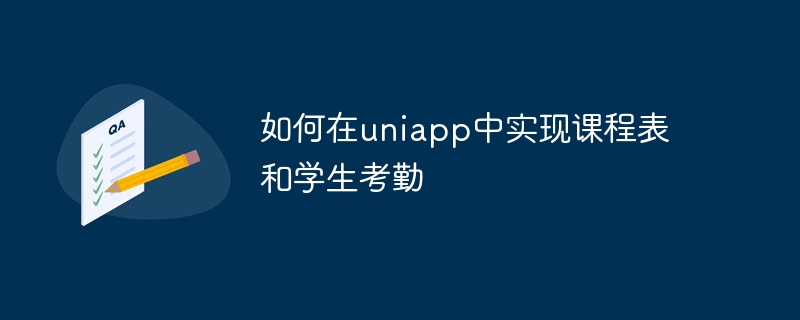Home >Web Front-end >uni-app >How to implement class schedule and student attendance in uniapp
How to implement class schedule and student attendance in uniapp
- WBOYWBOYWBOYWBOYWBOYWBOYWBOYWBOYWBOYWBOYWBOYWBOYWBOriginal
- 2023-10-20 09:41:061442browse

Implementing class schedules and student attendance in Uniapp can be completed by using the Vue.js framework and related plug-ins. The implementation steps and code examples will be introduced in detail below.
1. Course schedule implementation:
-
To create a course schedule page, you can use the uni-page component officially provided by uni-app to create a page template:
<template> <view class="container"> <view class="header">课程表</view> <view class="main"> <!-- 课程表内容 --> <!-- 根据后端返回的课程数据循环显示课程 --> <view v-for="course in courses" :key="course.id" class="course-item"> <text>{{ course.name }}</text> <text>{{ course.time }}</text> <text>{{ course.location }}</text> </view> </view> </view> </template> <script> export default { data() { return { // 假设后端返回的课程数据如下 courses: [ { id: 1, name: '语文', time: '周一 8:00-10:00', location: '教室A', }, { id: 2, name: '数学', time: '周一 10:30-12:30', location: '教室B', }, // 其他课程数据... ], }; }, }; </script> <style> .container { /* 样式设置,可根据实际需要自行调整 */ } .header { /* 样式设置,可根据实际需要自行调整 */ } .main { /* 样式设置,可根据实际需要自行调整 */ } .course-item { /* 样式设置,可根据实际需要自行调整 */ } </style> -
Page jump and introduction
Use the navigator component provided by uni-app to jump to the page that needs to display the course schedule, and introduce the course schedule component into the page:<template> <view class="container"> <navigator url="../courseTable/courseTable">进入课程表</navigator> </view> </template>
-
Configure routing
Add the routing configuration of the course schedule page in the routing configuration file of uni-app (usually/router/index.js):const routes = [ // 其他路由配置... { path: '/courseTable', name: 'CourseTable', component: () => import('@/pages/courseTable/courseTable.vue'), }, // 其他路由配置... ];In this way, you can view the course schedule page by clicking the "Enter Course Schedule" button.
2. Student attendance implementation:
-
Create attendance page
Use a similar method to create a student attendance page, you can use forms and buttons Implement the student check-in function:<template> <view class="container"> <view class="header">学生考勤</view> <view class="main"> <!-- 学生考勤表单 --> <form @submit="signIn"> <input type="text" v-model="studentId" placeholder="请输入学生ID"> <button type="submit">签到</button> </form> </view> </view> </template> <script> export default { data() { return { studentId: '', // 学生ID }; }, methods: { signIn() { // 提交签到数据到后端进行处理 // 例如使用uni.request()方法向后端发送签到请求 // 代码示例: uni.request({ url: 'https://www.example.com/signIn', data: { studentId: this.studentId, }, success: (res) => { // 签到成功处理逻辑 console.log('签到成功'); }, fail: (err) => { // 签到失败处理逻辑 console.log('签到失败', err); }, }); }, }, }; </script> <style> .container { /* 样式设置,可根据实际需要自行调整 */ } .header { /* 样式设置,可根据实际需要自行调整 */ } .main { /* 样式设置,可根据实际需要自行调整 */ } </style> -
Page jump and introduction
Similar to the course schedule, add navigation buttons to the page where the student attendance page needs to be displayed, and introduce the student attendance component:<template> <view class="container"> <navigator url="../attendance/attendance">进入学生考勤</navigator> </view> </template>
-
Configure routing
Also add the routing configuration of the student attendance page in the routing configuration file:const routes = [ // 其他路由配置... { path: '/attendance', name: 'Attendance', component: () => import('@/pages/attendance/attendance.vue'), }, // 其他路由配置... ];In this way, you can click the "Enter Student Attendance" button Enter the student attendance page.
The above are specific code examples for implementing curriculum and student attendance in Uniapp. Through the above steps, the functions of curriculum display and student attendance can be completed. According to actual needs, appropriate modifications and adjustments can be made based on the sample code.
The above is the detailed content of How to implement class schedule and student attendance in uniapp. For more information, please follow other related articles on the PHP Chinese website!

